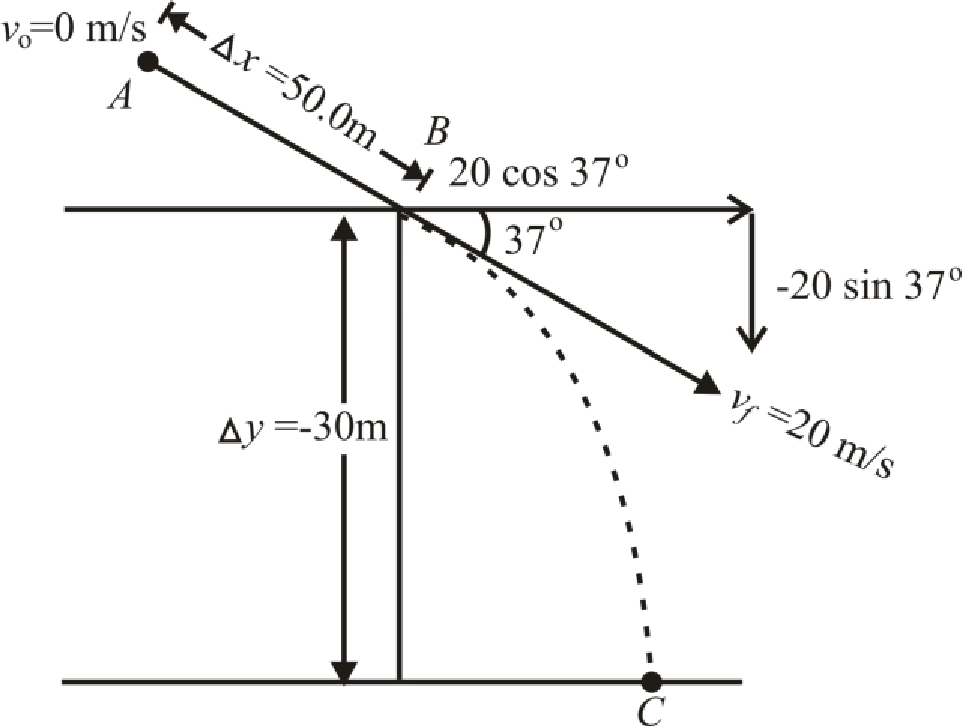
Concept explainers
(a)
The speed of the car at the edge of the cliff.
(a)
Answer to Problem 77AP
The speed of the car is
Explanation of Solution
Draw the below figure as per given instruction.

The car has acceleration while it is on the slope and a different acceleration when it is falling. Take the motion apart into two different sections.
A chunk of motion is during the acceleration stays constant. The acceleration will change instantaneously at the brink of the cliff. The velocity and the position must be the same just before point
From point
Write the expression for position along the incline plane as.
Here,
Conclusion:
Substitute
Solve and rearrange the above expression in terms of
Thus, the speed of the car is
(b)
The elapsed time interval.
(b)
Answer to Problem 77AP
The time elapsed time interval is
Explanation of Solution
Use first equation of motion for the time interval.
Write the expression for motion in straight line as.
Here,
Rearrange the above equation in terms of
Conclusion:
Substitute
Thus, the time elapsed time interval is
(c)
The velocity of the car.
(c)
Answer to Problem 77AP
The velocity of the car is
Explanation of Solution
Initial velocity is same as final velocity as horizontal acceleration is zero for uniform velocity. The velocity can be written as initial and final velocity component.
Write the expression for final velocity along horizontal as.
Here,
Write the expression for initial velocity along vertical as.
Here,
Write the expression for final velocity in
Here,
Rearrange the above expression as final velocity as.
Write the expression for total velocity for the whole distance as.
Here,
Conclusion:
Substitute
Substitute
Substitute
Substitute
Thus, the velocity of the car is
(d)
The total time interval the car is in motion.
(d)
Answer to Problem 77AP
The time interval for the total journey is
Explanation of Solution
Refer to drawn figure, the total time interval can be written as the sum of time required to cover distance
Write the expression for total time interval as.
Here,
Write the expression for time required to cover distance
Conclusion:
Substitute
Substitute
Thus, the time interval for the total journey is
(e)
The position of the car.
(e)
Answer to Problem 77AP
The horizontal distance covered by the time
Explanation of Solution
Write the expression for horizontal distance in time
Conclusion:
Substitute
Thus, the horizontal distance covered by the time
Want to see more full solutions like this?
Chapter 4 Solutions
Physics for Scientists and Engineers with Modern Physics, Technology Update
- In the movie Fast X, a 10100 kg round bomb is set rolling in Rome. The bomb gets up to 17.6 m/s. To try to stop the bomb, the protagonist Dom swings the counterweight of a crane, which has a mass of 354000 kg into the bomb at 3.61 m/s in the opposite direction. Directly after the collision the crane counterweight continues in the same direction it was going at 2.13 m/s. What is the velocity (magnitude and direction) of the bomb right after the collision?arrow_forwardDon't use aiarrow_forwardMake sure to draw a sketch with scale pleasearrow_forward
- Make sure to draw a sketch with scalearrow_forwardUltimate Byleth and Little Mac fight. Little Mac, who is a boxer, dashes forward at 26.6 m/s, fist first. Byleth moves in the opposite direction at 3.79 m/s, where they collide with Little Mac’s fist. After the punch Byleth flies backwards at 11.1 m/s. How fast, and in what direction, is Little Mac now moving? Little Mac has a mass of 48.5 kg and Byleth has a mass of 72.0 kg.arrow_forwardMake sure to draw a sketch with scale as wellarrow_forward
- Make sure to draw a sketch with scale pleasearrow_forwardKirby jumps towards his enemy/ally, Meta Knight, at 2.06 m/s while Meta Knight glides in the opposite direction (toward Kirby) at 5.06 m/s. Kirby then begins to inhale, swallowing Meta Knight. What is Kirby/Meta Knight’s velocity immediately after being swallowed? Please put the magnitude of the velocity and then mark direction using dropdown menu. Kirby has a mass of 0.283 kg and Meta Knight has a mass of 0.538 kg.arrow_forwardNo Aiarrow_forward
 Principles of Physics: A Calculus-Based TextPhysicsISBN:9781133104261Author:Raymond A. Serway, John W. JewettPublisher:Cengage Learning
Principles of Physics: A Calculus-Based TextPhysicsISBN:9781133104261Author:Raymond A. Serway, John W. JewettPublisher:Cengage Learning Glencoe Physics: Principles and Problems, Student...PhysicsISBN:9780078807213Author:Paul W. ZitzewitzPublisher:Glencoe/McGraw-Hill
Glencoe Physics: Principles and Problems, Student...PhysicsISBN:9780078807213Author:Paul W. ZitzewitzPublisher:Glencoe/McGraw-Hill Physics for Scientists and Engineers, Technology ...PhysicsISBN:9781305116399Author:Raymond A. Serway, John W. JewettPublisher:Cengage Learning
Physics for Scientists and Engineers, Technology ...PhysicsISBN:9781305116399Author:Raymond A. Serway, John W. JewettPublisher:Cengage Learning Classical Dynamics of Particles and SystemsPhysicsISBN:9780534408961Author:Stephen T. Thornton, Jerry B. MarionPublisher:Cengage Learning
Classical Dynamics of Particles and SystemsPhysicsISBN:9780534408961Author:Stephen T. Thornton, Jerry B. MarionPublisher:Cengage Learning University Physics Volume 1PhysicsISBN:9781938168277Author:William Moebs, Samuel J. Ling, Jeff SannyPublisher:OpenStax - Rice University
University Physics Volume 1PhysicsISBN:9781938168277Author:William Moebs, Samuel J. Ling, Jeff SannyPublisher:OpenStax - Rice University College PhysicsPhysicsISBN:9781285737027Author:Raymond A. Serway, Chris VuillePublisher:Cengage Learning
College PhysicsPhysicsISBN:9781285737027Author:Raymond A. Serway, Chris VuillePublisher:Cengage Learning





